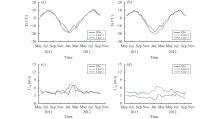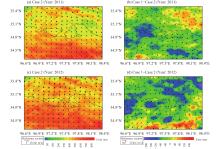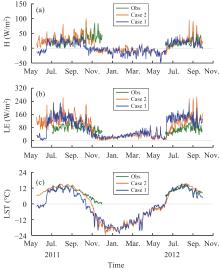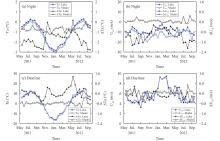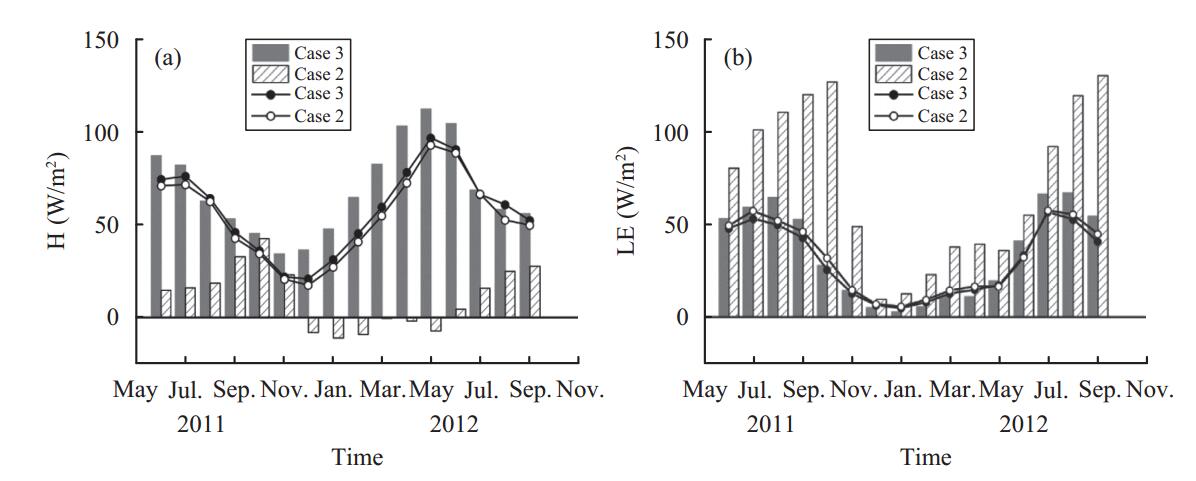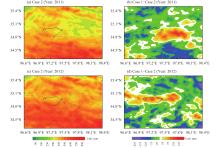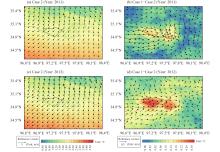Sciences in Cold and Arid Regions ›› 2018, Vol. 10 ›› Issue (5): 379–391.doi: 10.3724/SP.J.1226.2018.00379
Numerical simulation of the climate effect of high-altitude lakes on the Tibetan Plateau
YinHuan Ao1,ShiHua Lyu2,3,ZhaoGuo Li1,*( ),LiJuan Wen1,Lin Zhao1
),LiJuan Wen1,Lin Zhao1
- 1 Key Laboratory of Land Surface Process and Climate Change in Cold and Arid Regions, Northwest Institute of Eco-En-vironment and Resources, Chinese Academy of Sciences, Lanzhou, Gansu 730000, China
2 Plateau Atmosphere and Environment Key Laboratory of Sichuan Province, School of Atmospheric Sciences, Chengdu University of Information Technology, Chengdu, Sichuan 610225, China
3 Collaborative Innovation Center on Forecast and Evaluation of Meteorological Disasters, Nanjing University of Information Science & Technology, Nanjing, Jiangsu 210044, China
| 1 |
Balsamo G, Salgado R, Dutra E, et al. On the contribution of lakes in predicting near-surface temperature in a global weather forecasting model. Tellus A: Dynamic Meteorology and Oceanography 2012; 64: 1 15829.
doi: 10.3402/tellusa.v64i0.15829 |
| 2 |
Bates GT, Giorgi F, Hostetler SW Toward the simulation of the effects of the Great Lakes on regional climate. Monthly Weather Review 1993; 121: 5 1373- 1387.
doi: 10.1175/1520-0493(1993)121<1373:TTSOTE>2.0.CO;2 |
| 3 |
Biermann T, Babel W, Ma WQ, et al. Turbulent flux observations and modelling over a shallow lake and a wet grassland in the Nam Co Basin, Tibetan Plateau. Theoretical and Applied Climatology 2014; 116: 1–2 301- 316.
doi: 10.1007/s00704-013-0953-6 |
| 4 |
Chen F, Dudhia J Coupling an advanced land surface-hydrology model with the Penn State-NCAR MM5 modeling system. Part I: model implementation and sensitivity. Monthly Weather Review 2001; 129: 4 569- 585.
doi: 10.1175/1520-0493(2001)129<0569:CAALSH>2.0.CO;2 |
| 5 |
Clough SA, Shephard MW, Mlawer EJ, et al. Atmospheric radiative transfer modeling: a summary of the AER codes. Journal of Quantitative Spectroscopy and Radiative Transfer 2005; 91: 2 233- 244.
doi: 10.1016/j.jqsrt.2004.05.058 |
| 6 | Downing JA Emerging global role of small lakes and ponds: little things mean a lot. Limnetica 2010; 29: 1 9- 24. |
| 7 | Dutra E, Stepanenko VM, Balsamo G, et al. An offline study of the impact of lakes on the performance of the ECMWF surface scheme. Boreal Environment Research 2010; 15: 2 100- 112. |
| 8 | Eerola K, Rontu L, Kourzeneva E, et al. A study on effects of lake temperature and ice cover in HIRLAM. Boreal Environment Research 2010; 15: 2 130- 142. |
| 9 |
Ellis AW, Leathers DJ A synoptic climatological approach to the analysis of lake-effect snowfall: potential forecasting applications. Weather and Forecasting 1996; 11: 2 216- 229.
doi: 10.1175/1520-0434(1996)011<0216:ASCATT>2.0.CO;2 |
| 10 |
Gerbush MR, Kristovich DAR, Laird NF Mesoscale boundary layer and heat flux variations over pack ice–covered lake Erie. Journal of Applied Meteorology and Climatology 2008; 47: 2 668- 682.
doi: 10.1175/2007JAMC1479.1 |
| 11 |
Grachev AA, Bariteau L, Fairall CW, et al. Turbulent fluxes and transfer of trace gases from ship-based measurements during TexAQS 2006. Journal of Geophysical Research: Atmospheres 2011; 116: D13 D13110.
doi: 10.1029/2010JD015502 |
| 12 |
Gu HP, Jin JM, Wu YH, et al. Calibration and validation of lake surface temperature simulations with the coupled WRF-lake model. Climatic Change 2015; 129: 3–4 471- 483.
doi: 10.1007/s10584-013-0978-y |
| 13 |
Hondzo M, Stefan HG Regional water temperature characteristics of lakes subjected to climate change. Climatic Change 1993; 24: 3 187- 211.
doi: 10.1007/BF01091829 |
| 14 | Hong SY, Lim JOJ The WRF single-moment 6-class microphysics scheme (WSM6). Journal of the Korean Meteorological Society 2006; 42: 2 129- 151. |
| 15 |
Huang WF, Han HW, Shi LQ, et al. Effective thermal conductivity of thermokarst lake ice in Beiluhe Basin, Qinghai-Tibet Plateau. Cold Regions Science and Technology 2013; 85: 34- 41.
doi: 10.1016/j.coldregions.2012.08.001 |
| 16 |
Huang WF, Li RL, Han HW, et al. Ice processes and surface ablation in a shallow thermokarst lake in the central Qinghai–Tibetan Plateau. Annals of Glaciology 2016; 57: 71 20- 28.
doi: 10.3189/2016AoG71A016 |
| 17 |
Jeffries MO, Zhang TJ, Frey K, et al. Estimating late-winter heat flow to the atmosphere from the lake-dominated Alaskan North Slope. Journal of Glaciology 1999; 45: 150 315- 324.
doi: 10.3189/S0022143000001817 |
| 18 |
Kain JS The Kain–Fritsch convective parameterization: an update and climatology. Journal of Applied Meteorology 2004; 43: 1 170- 181.
doi: 10.1175/1520-0450(2004)043<0170:TKCPAU>2.0.CO;2 |
| 19 |
Kristovich DAR, Braham Jr RR Mean profiles of moisture fluxes in snow-filled boundary layers. Boundary-Layer Meteorology 1998; 87: 2 195- 215.
doi: 10.1023/A:1000836401204 |
| 20 |
Kristovich DAR, Laird NF Observations of widespread lake-effect cloudiness: influences of lake surface temperature and upwind conditions. Weather and Forecasting 1998; 13: 3 811- 821.
doi: 10.1175/1520-0434(1998)013<0811:OOWLEC>2.0.CO;2 |
| 21 |
Lavoie RL A mesoscale numerical model of lake-effect storms. Journal of the Atmospheric Sciences 1972; 29: 6 1025- 1040.
doi: 10.1175/1520-0469(1972)029<1025:AMNMOL>2.0.CO;2 |
| 22 |
Le Moigne P, Colin J, Decharme B Impact of lake surface temperatures simulated by the FLake scheme in the CNRM-CM5 climate model. Tellus A: Dynamic Meteorology and Oceanography 2016; 68: 1 31274.
doi: 10.3402/tellusa.v68.31274 |
| 23 |
Li XL, Pu ZX Sensitivity of numerical simulations of the early rapid intensification of Hurricane Emily to cumulus parameterization schemes in different model horizontal resolutions. Journal of the Meteorological Society of Japan 2009; 87: 3 403- 421.
doi: 10.2151/jmsj.87.403 |
| 24 |
Li ZG, Lyu S, Ao Y, et al. Long-term energy flux and radiation balance observations over Lake Ngoring, Tibetan Plateau. Atmospheric Research 2015; 155: 13- 25.
doi: 10.1016/j.atmosres.2014.11.019 |
| 25 |
Li ZG, Lyu S, Zhao L, et al. Turbulent transfer coefficient and roughness length in a high-altitude lake, Tibetan Plateau. Theoretical and Applied Climatology 2016; 124: 3–4 723- 735.
doi: 10.1007/s00704-015-1440-z |
| 26 |
Li ZG, Lyu S, Wen LJ, et al. Effect of a cold, dry air incursion on atmospheric boundary layer processes over a high-altitude lake in the Tibetan Plateau. Atmospheric Research 2017; 185: 32- 43.
doi: 10.1016/j.atmosres.2016.10.024 |
| 27 |
Li ZG, Lyu S, Wen LJ, et al. Effect of roughness lengths on surface energy and the planetary boundary layer height over high-altitude Ngoring Lake. Theoretical and Applied Climatology 2018; 133: 3–4 1191- 1205.
doi: 10.1007/s00704-017-2258-7 |
| 28 |
Lofgren BM Simulated effects of idealized laurentian Great Lakes onregional and large-scale climate. Journal of Climate 1997; 10: 11 2847- 2858.
doi: 10.1175/1520-0442(1997)010<2847:SEOILG>2.0.CO;2 |
| 29 |
Lofgren BM A model for simulation of the climate and hydrology of the Great Lakes basin. Journal of Geophysical Research: Atmospheres 2004; 109: D18 D18108.
doi: 10.1029/2004JD004602 |
| 30 |
Long Z, Perrie W, Gyakum J, et al. Northern lake impacts on local seasonal climate. Journal of Hydrometeorology 2007; 8: 4 881- 896.
doi: 10.1175/JHM591.1 |
| 31 |
Mahrt L, Vickers D, Frederickson P, et al. Sea-surface aerodynamic roughness. Journal of Geophysical Research: Oceans 2003; 108: C6 3171.
doi: 10.1029/2002JC001383 |
| 32 |
Maussion F, Scherer D, Finkelnburg R, et al. WRF simulation of a precipitation event over the Tibetan Plateau, China—an assessment using remote sensing and ground observations. Hydrology and Earth System Sciences 2011; 15: 6 1795- 1817.
doi: 10.5194/hess-15-1795-2011 |
| 33 |
Nasrollahi N, AghaKouchak A, Li JL, et al. Assessing the impacts of different WRF precipitation physics in hurricane simulations. Weather and Forecasting 2012; 27: 4 1003- 1016.
doi: 10.1175/WAF-D-10-05000.1 |
| 34 |
Niziol TA, Snyder WR, Waldstreicher JS Winter weather forecasting throughout the eastern United States. Part IV: lake effect snow. Weather and Forecasting 1995; 10: 1 61- 77.
doi: 10.1175/1520-0434(1995)010<0061:WWFTTE>2.0.CO;2 |
| 35 |
Norton DC, Bolsenga SJ Spatiotemporal trends in lake effect and continental snowfall in the Laurentian Great Lakes, 1951–1980. Journal of Climate 1993; 6: 10 1943- 1956.
doi: 10.1175/1520-0442(1993)006<1943:STILEA>2.0.CO;2 |
| 36 | Oleson KW, Lawrence DM, Bonan GB, et al., 2013. Technical description of version 4.5 of the community land model (CLM). NCAR Technical Note NCAR/TN-503+STR. Boulder, Colorado, USA: NCAR, pp. 205–206. DOI: 10.5065/D6RR1W7M. |
| 37 |
Pleim JE A combined local and nonlocal closure model for the atmospheric boundary layer. Part I: model description and testing. Journal of Applied Meteorology and Climatology 2007; 46: 9 1383- 1395.
doi: 10.1175/JAM2539.1 |
| 38 |
Read JS, Hamilton DP, Desai AR, et al. Lake-size dependency of wind shear and convection as controls on gas exchange. Geophysical Research Letters 2012; 39: 9 L09405.
doi: 10.1029/2012GL051886 |
| 39 |
Rouse WR, Oswald CJ, Binyamin J, et al. The role of northern lakes in a regional energy balance. Journal of Hydrometeorology 2005; 6: 3 291- 305.
doi: 10.1175/JHM421.1 |
| 40 | Samuelsson P, Kourzeneva E, Mironov D The impact of lakes on the European climate as simulated by a regional climate model. Boreal Environment Research 2010; 15: 2 113- 129. |
| 41 | Skamarock WC, Klemp JB, Dudhia J, et al., 2005. A description of the advanced research WRF version 2. NCAR Technical Note NCAR/TN-468+STR. Boulder, Colorado, USA: NCAR. |
| 42 |
Song CQ, Huang B, Richards K, et al. Accelerated lake expansion on the Tibetan Plateau in the 2000s: induced by glacial melting or other processes?. Water Resources Research 2014; 50: 4 3170- 3186.
doi: 10.1002/2013WR014724 |
| 43 |
Subin ZM, Riley WJ, Mironov D An improved lake model for climate simulations: model structure, evaluation, and sensitivity analyses in CESM1. Journal of Advances in Modeling Earth Systems 2012; 4: 1 M02001.
doi: 10.1029/2011MS000072 |
| 44 |
Torbick N, Ziniti B, Wu S, et al. Spatiotemporal lake skin summer temperature trends in the northeast United States. Earth Interactions 2016; 20: 25 1- 21.
doi: 10.1175/EI-D-16-0015.1 |
| 45 |
Vachon D, Prairie YT The ecosystem size and shape dependence of gas transfer velocity versus wind speed relationships in lakes. Canadian Journal of Fisheries and Aquatic Sciences 2013; 70: 12 1757- 1764.
doi: 10.1139/cjfas-2013-0241 |
| 46 |
Vickers D, Mahrt L Sea-surface roughness lengths in the midlatitude coastal zone. Quarterly Journal of the Royal Meteorological Society 2010; 136: 649 1089- 1093.
doi: 10.1002/qj.617 |
| 47 |
Wan W, Long D, Hong Y, et al. A lake data set for the Tibetan Plateau from the 1960s, 2005, and 2014. Scientific Data 2016; 3: 160039.
doi: 10.1038/sdata.2016.39 |
| 48 |
Wang BB, Ma YM, Ma WQ, et al. Physical controls on half-hourly, daily, and monthly turbulent flux and energy budget over a high—altitude small lake on the Tibetan Plateau. Journal of Geophysical Research: Atmospheres 2017; 122: 4 2289- 2303.
doi: 10.1002/2016JD026109 |
| 49 |
Wei ZW, Miyano A, Sugita M Drag and bulk transfer coefficients over water surfaces in light winds. Boundary-Layer Meteorology 2016; 160: 2 319- 346.
doi: 10.1007/s10546-016-0147-8 |
| 50 |
Wen LJ, Lv SH, Li ZG, et al. Impacts of the two biggest lakes on local temperature and precipitation in the Yellow River source region of the Tibetan Plateau. Advances in Meteorology 2015; 2015: 248031.
doi: 10.1155/2015/248031 |
| 51 |
Wilson JW Effect of Lake Ontario on precipitation. Monthly Weather Review 1977; 105: 2 207- 214.
doi: 10.1175/1520-0493(1977)105<0207:EOLOOP>2.0.CO;2 |
| 52 |
Woolway RI, Jones ID, Hamilton DP, et al. Automated calculation of surface energy fluxes with high-frequency lake buoy data. Environmental Modelling & Software 2015; 70: 191- 198.
doi: 10.1016/j.envsoft.2015.04.013 |
| 53 |
Woolway RI, Jones ID, Maberly SC, et al. Diel surface temperature range scales with lake size. PLoS One 2016; 11: 3 e0152466.
doi: 10.1371/journal.pone.0152466 |
| 54 |
Woolway RI, Verburg P, Merchant CJ, et al. Latitude and lake size are important predictors of over-lake atmospheric stability. Geophysical Research Letters 2017; 44: 17 8875- 8883.
doi: 10.1002/2017GL073941 |
| 55 |
Wright DM, Posselt DJ, Steiner AL Sensitivity of lake-effect snowfall to lake ice cover and temperature in the great lakes region. Monthly Weather Review 2013; 141: 2 670- 689.
doi: 10.1175/MWR-D-12-00038.1 |
| 56 |
Xu LJ, Liu HZ, Du Q, et al. Evaluation of the WRF-lake model over a highland freshwater lake in southwest China. Journal of Geophysical Research: Atmospheres 2016; 121: 23 13989- 14005.
doi: 10.1002/2016JD025396 |
| 57 |
Yang K, Lu H, Yue SY, et al. Quantifying recent precipitation change and predicting lake expansion in the Inner Tibetan Plateau. Climatic Change 2018; 147: 1–2 149- 163.
doi: 10.1007/s10584-017-2127-5 |
| 58 |
Yang K, Wu H, Qin J, et al. Recent climate changes over the Tibetan Plateau and their impacts on energy and water cycle: a review. Global and Planetary Change 2014; 112: 79- 91.
doi: 10.1016/j.gloplacha.2013.12.001 |
| 59 |
Yao JM, Zhao L, Gu LL, et al. The surface energy budget in the permafrost region of the Tibetan Plateau. Atmospheric Research 2011; 102: 4 394- 407.
doi: 10.1016/j.atmosres.2011.09.001 |
| 60 | Ye QH, Wei QF, Hochschild V, et al., 2011. Integrated observations of lake ice at Nam Co on the Tibetan Plateau from 2001 to 2009. In: Proceedings of 2011 IEEE International Geoscience and Remote Sensing Symposium. Vancouver, BC, Canada: IEEE, pp. 3217–3220. DOI: 10.1109/IGARSS.2011.6049904. |
| 61 |
Zhang GQ, Yao TD, Xie HJ, et al. Increased mass over the Tibetan Plateau: from lakes or glaciers?. Geophysical Research Letters 2013; 40: 10 2125- 2130.
doi: 10.1002/grl.50462 |
| 62 |
Zhang Q Study on depth of atmospheric thermal boundary layer in extreme arid desert regions. Journal of Desert Research 2007; 27: 4 614- 620.
doi: 10.3321/j.issn:1000-694X.2007.04.015 |
| 63 |
Zhao L, Jin JM, Wang SY, et al. Integration of remote-sensing data with WRF to improve lake-effect precipitation simulations over the Great Lakes region. Journal of Geophysical Research: Atmospheres 2012; 117: D9 D09102.
doi: 10.1029/2011JD016979 |
| 64 |
Zilitinkevich SS, Grachev AA, Fairall CW Notes and correspondecescaling reasoning and field data on the sea surface roughness lengths for scalars. Journal of the Atmospheric Sciences 2001; 58: 3 320- 325.
doi: 10.1175/1520-0469(2001)058<0320:NACRAF>2.0.CO;2 |
| No related articles found! |





